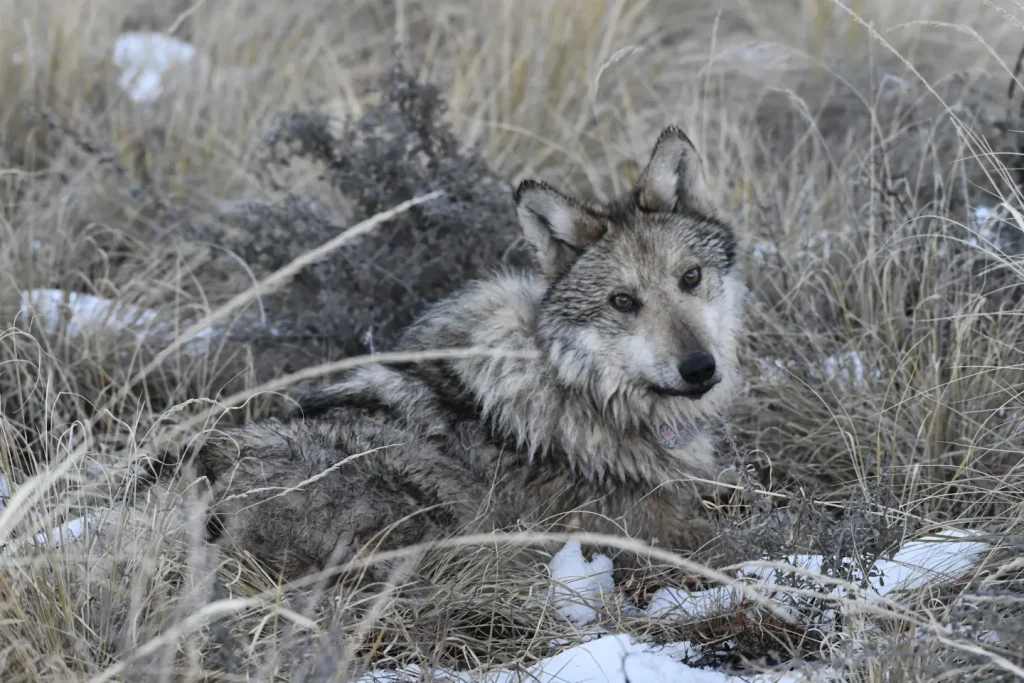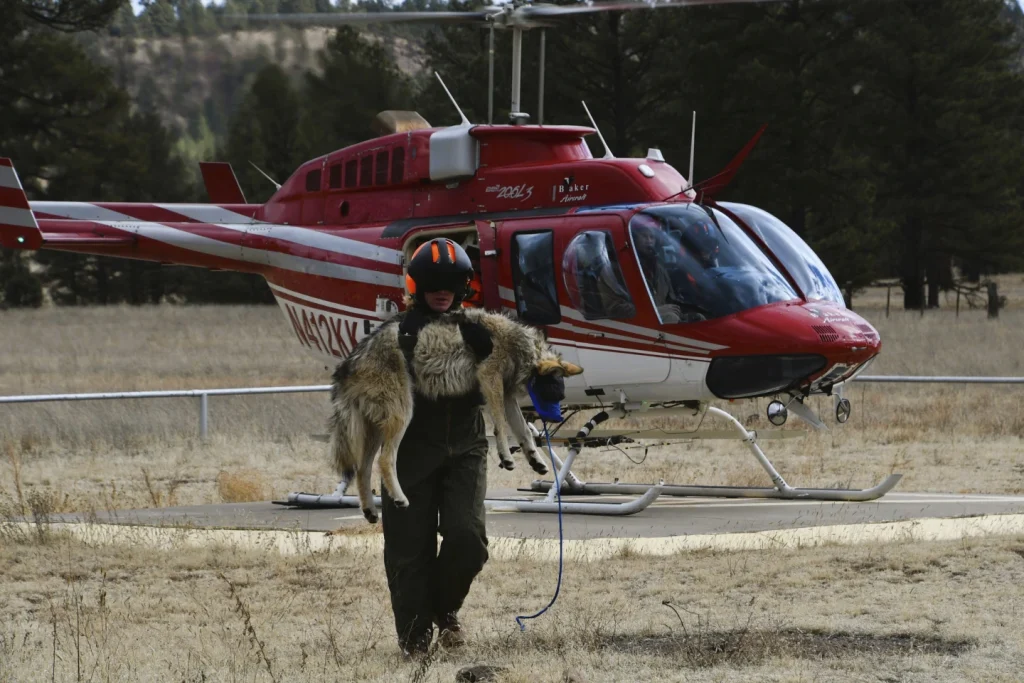The Mexican gray wolf, an iconic species native to the southwestern United States, has been the focus of conservation efforts aimed at bolstering its dwindling population.
Despite recent reports indicating a growth in the wild population, concerns over inbreeding and the resulting genetic crisis loom large, posing a significant threat to the long-term survival of these endangered animals.
The latest findings, disclosed by the U.S. Fish and Wildlife Service and wildlife agencies in Arizona and New Mexico, revealed a total of 257 Mexican gray wolves inhabiting various regions across the two states.
This figure represents an increase of 15 wolves compared to the previous year, marking a positive trend in the overall population size since the inception of the reintroduction program over a quarter of a century ago.
However, environmental advocates caution against interpreting this population growth as an unequivocal success story.
Rather, they argue that the escalation in numbers exacerbates the genetic crisis afflicting Mexican gray wolves, making it increasingly challenging to rectify the issue as the population expands.
Greta Anderson, deputy director of the Western Watersheds Project, emphasized the critical importance of addressing genetic diversity concerns through enhanced policies governing the release of adult wolves and family groups into the wild.
For years, environmental organizations have been lobbying the federal government to augment the release of captive wolves into their natural habitat and to reassess existing policies that restrict the movement of wolves within arbitrary boundaries.
Presently, wolves that stray beyond Interstate 40 in Arizona and New Mexico are captured and either returned to the designated wolf recovery zone or placed in captivity, where they may be paired with potential mates.
In response to these challenges, federal and state wildlife officials engaged in Mexican wolf recovery efforts advocate for genetic management strategies that involve introducing captive-born pups into wild dens to broaden the genetic diversity of the population.
Over the past five years, nearly 99 pups born in captivity have been integrated into 40 wild dens, a measure aimed at mitigating the adverse effects of inbreeding and enhancing the overall genetic health of Mexican gray wolves.
The delicate balance between population growth and genetic diversity underscores the complex nature of conservation efforts aimed at safeguarding endangered species like the Mexican gray wolf.
While the recent uptick in wolf numbers is a positive development, the persistent threat of inbreeding necessitates continued vigilance and innovative conservation strategies to ensure the long-term viability of these majestic animals in their natural habitat.
According to recent survey findings, a noteworthy accomplishment has been observed in the realm of Mexican wolf conservation efforts over the past year.
Reports indicate that a minimum of 15 fostered wolf pups have not only managed to survive to breeding age but have also thrived in the wild.
Furthermore, it has been documented that at least 10 fostered wolves have successfully engaged in breeding activities, resulting in the birth of litters within their natural habitat.
Brady McGee, the Mexican wolf recovery coordinator at the U.S. Fish and Wildlife Service, expressed optimism regarding the efficacy of fostering practices, emphasizing the significance of witnessing fostered Mexican wolves not only survive but disperse, form pairs, breed, and establish their own packs.
McGee’s sentiments highlight a tangible success story in the ongoing efforts to bolster the Mexican wolf population.
On the other hand, Michael Robinson, a senior conservation advocate at the Center for Biological Diversity, raised concerns about the historical challenges faced by fostered pups in the wild.
Robinson noted instances where many released pups had vanished or succumbed to mortality, underscoring the precarious nature of reintroducing wolves into their natural environment.
He further highlighted the genetic intricacies within the Mexican gray wolf population, pointing out that while the captive individuals exhibit some degree of genetic diversity, the wild population faces inherent challenges of inbreeding due to the close genetic relatedness among individuals.
Robinson also shed light on the practice of artificial feeding of wild wolves by the Fish and Wildlife Service, noting that while this intervention has proven beneficial in enhancing fertility rates and pup survival, it has not fully addressed the underlying issue of inbreeding.
To mitigate these genetic challenges, wildlife managers have resorted to supplemental food caches for packs containing fostered pups, particularly during the initial six months post-release.
This multi-faceted approach underscores the intricate balance between conservation efforts and genetic sustainability in the ongoing conservation initiatives aimed at preserving the Mexican gray wolf population.
The debate surrounding the release of captive wolf families is a complex and contentious issue that has sparked renewed discussions and calls for action.
Advocates for releasing more wolf families argue that such efforts would lead to higher success rates in wolf conservation and population management.
On the other hand, ranchers and rural residents have expressed concerns about the potential impact of releasing more wolves on their livelihoods, citing instances of livestock predation by wolves as a major source of conflict.
The ongoing conflict between wildlife conservationists and rural communities underscores the delicate balance that must be struck between protecting endangered species and supporting the economic interests of those who live and work in areas where these species roam.
While compensation funds are available to mitigate some of the financial losses incurred by ranchers due to wolf predation, many argue that these funds are often insufficient to fully cover the costs of lost livestock or the expenses associated with implementing deterrent measures.
Furthermore, recent changes to federal standards for determining whether livestock killings were caused by wolves have raised concerns among ranchers about the potential challenges they may face in seeking compensation for their losses.
The implementation of stricter criteria for verifying wolf-related livestock deaths could further complicate the process of accessing financial assistance, adding to the frustrations felt by those already grappling with the impacts of wolf predation on their businesses.
In response to these challenges, New Mexico lawmakers have taken steps to address the issue by allocating $1.5 million in their budget proposal to support existing compensation efforts over a two-year period, starting from the following year.
This financial commitment reflects a recognition of the need to provide adequate support to ranchers and rural communities affected by wolf predation while also acknowledging the importance of wolf conservation efforts in the state.

The decision on whether to approve this budget allocation now rests with Democratic Governor Michelle Lujan Grisham, who faces a deadline to sign the budget and related legislation following the conclusion of the recent 30-day legislative session.
The outcome of this decision will have far-reaching implications for the future of wolf conservation and ranching in New Mexico, highlighting the complex interplay between wildlife management, economic interests, and policy-making.
As stakeholders on all sides continue to grapple with the competing demands of wildlife conservation and rural livelihoods, finding common ground and sustainable solutions will be crucial in addressing the challenges posed by the coexistence of wolves and humans in shared landscapes.
By fostering dialogue, promoting collaboration, and seeking innovative approaches to conflict resolution, it may be possible to forge a path forward that supports both the conservation of endangered species and the well-being of rural communities.
